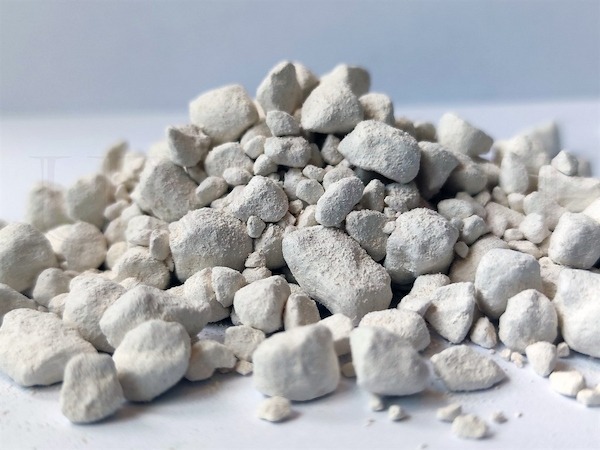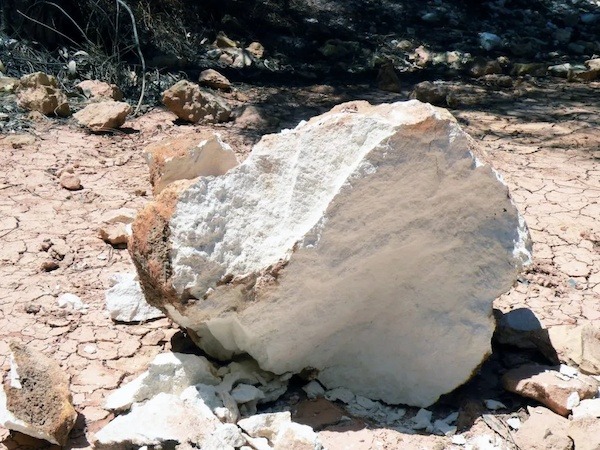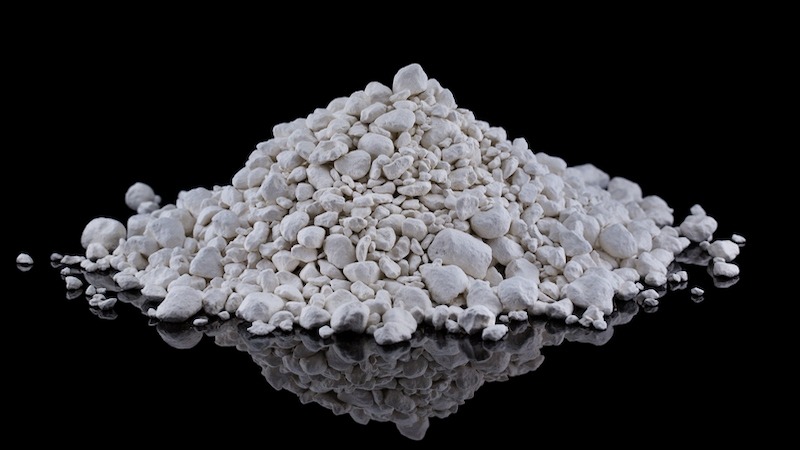Kaolinite is a clay mineral that, in the commercial language, is called Kaolin. Its name was derived from the name of a mountain in China called Gaoling, where Kaolin was discovered first. Most of the economic kaolin clays are produced by the alteration of acidic volcanic stones. Most of the time, in kaolin, there are minerals other than kaolinite alone, like quartz, feldspar, etc. which deeply affect the procedure of kaolin production. This can also include Iron oxide (Fe2O3) and Iron (II) hydroxide Fe(OH)2, Pyrite (FeS2), Titanium dioxide (TiO2), and compounds containing carbonates and organic materials.  Production of kaolinite involves the alteration of feldspars or feldspar-like materials, erosion, and formation of clays. To produce kaolin, very specific conditions are needed, in which chemical analysis of the stone and physical conditions of the production process, both play important roles in Kaolin’s manufacture. It is worth so say that in the meanwhile, the stability of clay minerals is not the same. Furthermore, the pH of the environment has a big effect on the physical process.
Production of kaolinite involves the alteration of feldspars or feldspar-like materials, erosion, and formation of clays. To produce kaolin, very specific conditions are needed, in which chemical analysis of the stone and physical conditions of the production process, both play important roles in Kaolin’s manufacture. It is worth so say that in the meanwhile, the stability of clay minerals is not the same. Furthermore, the pH of the environment has a big effect on the physical process.
Kaolin Clay Price per Ton
Many factors affect the final price of Kaolin clay per ton including the term of delivery (EXW, FOB, CIF, CFR, etc.). Since the Kaolin is not an expensive product, the shipping costs can significantly define its final price, hence it’s highly recommended that when you buy kaolin, consider its shipping costs seriously.  The FOB price of Kaolin in the Middle East ranges from 63$ to 106$ USD for a high-quality product which most of the time is a product of Iran. As you see, its 40’ FCL price which can take around 25 tons of kaolin would equal 3000$ USD at most, and the freight charge to the destination port ranges from 600$ USD to 10000$ USD based on the locations of the ports. No need to say that air transportation won’t be economic at all.
The FOB price of Kaolin in the Middle East ranges from 63$ to 106$ USD for a high-quality product which most of the time is a product of Iran. As you see, its 40’ FCL price which can take around 25 tons of kaolin would equal 3000$ USD at most, and the freight charge to the destination port ranges from 600$ USD to 10000$ USD based on the locations of the ports. No need to say that air transportation won’t be economic at all.
Clay Minerals Kaolinite, Montmorillonite and Illite
Since we’ve discussed kaolin in the above paragraphs, we don’t focus on it here. Montmorillonite is a member of the clay minerals family just like kaolin and illite that can be decomposed with the aid of x-ray and chemical reactions. Montmorillonite is the most found mineral in Bentonite. This clay is produced from the lava of volcanos and the decomposition of other minerals. One of the factors that greatly influence the ingredients and specifications of this mineral is the climate. Some of the materials that can be found in this mineral are potassium oxide and sodium oxide. One of the reasons that Montmorillonite doesn’t have a stable molecule structure is that it has got a high capacity in accepting ions in its crystal structure.  The name Montmorillonite is taken from a place in France called Montmorillon, where Montmorillonite was discovered and classified first. This clay is available in different colors like green, blue, gray, red, sometimes pink, white, and matt in dry mode. Its density is not constant and differs from 1.7 to 2.7 g/cm3. The existence of Montmorillonite in clays causes them to swell when they’re exposed to humidity and then gives a greasy feeling but this is not enough to confirm. The only way to detect it is with the help of x-ray scans and chemical analysis, otherwise, because of many common properties with other clay minerals, it’s almost impossible to detect it.
The name Montmorillonite is taken from a place in France called Montmorillon, where Montmorillonite was discovered and classified first. This clay is available in different colors like green, blue, gray, red, sometimes pink, white, and matt in dry mode. Its density is not constant and differs from 1.7 to 2.7 g/cm3. The existence of Montmorillonite in clays causes them to swell when they’re exposed to humidity and then gives a greasy feeling but this is not enough to confirm. The only way to detect it is with the help of x-ray scans and chemical analysis, otherwise, because of many common properties with other clay minerals, it’s almost impossible to detect it.
Kaolinite Properties
Technically, clays that contain significant amounts of kaolinite are called Kaolin. In the science of mineralogy, kaolin is one of the aluminum hydrate minerals. Kaolin, when it is pure has a white and yellowish-gray color. It is a very soft clay that you can crush even with your fingers. It can easily mix with water and is highly impervious. It releases a lot of water when dries without expansion. When you mix it with water, its dough can be easily formed. When it’s baked nothing changes in its shape and color, moreover, it severely shrinks during this process, and its reaction to the temperature fluctuations is significant. The purer it is, the more adhesive it becomes.  Most of the time, kaolin contains Na2O, MgO, K2O, TiO2, CaO, and Mica and Feldspar along with other organic materials and carbonates. What turns its color red is the presence of Iron oxide in it. It also turns brown when exposed to air for a longer time. It’s also stable in a wide range of pH environments, but it dissolves in dense sulphuric acid and becomes Cilic jelly. There will be no water molecules left in kaolin at 800 °C and turns into a semi-crystal mineral called metakaolin. If you heat it to a temperature that breaks its molecular bonding, SiO2 & Al2O3 will remain which are useful in the production of firebricks. Even the best kaolins have impurities that need to be concentrated to decrease their alkalinity to under 1.5%. Ironic compounds, volcanic stones, and metamorphic feldspars hurt the quality of kaolin. Gypsum is also one of the impurities in kaolin which lowers its melting point whereas its highness plus low water absorption and stability in high temperatures are exceptional qualities in kaolin that ranks it high among fireproof clays.
Most of the time, kaolin contains Na2O, MgO, K2O, TiO2, CaO, and Mica and Feldspar along with other organic materials and carbonates. What turns its color red is the presence of Iron oxide in it. It also turns brown when exposed to air for a longer time. It’s also stable in a wide range of pH environments, but it dissolves in dense sulphuric acid and becomes Cilic jelly. There will be no water molecules left in kaolin at 800 °C and turns into a semi-crystal mineral called metakaolin. If you heat it to a temperature that breaks its molecular bonding, SiO2 & Al2O3 will remain which are useful in the production of firebricks. Even the best kaolins have impurities that need to be concentrated to decrease their alkalinity to under 1.5%. Ironic compounds, volcanic stones, and metamorphic feldspars hurt the quality of kaolin. Gypsum is also one of the impurities in kaolin which lowers its melting point whereas its highness plus low water absorption and stability in high temperatures are exceptional qualities in kaolin that ranks it high among fireproof clays.
Kaolin Uses
Kaolin is being used in porcelain and ceramic production to control the formability of raw materials and strengthens the products against heat, dryness, and temperature fluctuations; it also smoothens the coated surface. High-quality kaolin used in the ceramic industry guarantees resistance, formability, and shiny products after bake. Suitable kaolin for paper production should have white color, should quickly suspend in water, have low density, and be well grained into powder. Its quartz amount should be low so that it does less damage to the machines. When kaolin is used less than 18% in tire industry production it causes the tire to stretch better and strengthen it against discomposure. Calcined kaolin is used for coating in this industry too.  In the paint and coating industry, is used in white color production as the main ingredient instead of titanium oxide. Calcined kaolin is of very important material in the paint and coating industry. It is also used in the plastic industries, fireproofs, construction materials, and agriculture. Even in gluing industry, fiberglass, cosmetics, hygienic, medicine, and catalyzer plays a big role.
In the paint and coating industry, is used in white color production as the main ingredient instead of titanium oxide. Calcined kaolin is of very important material in the paint and coating industry. It is also used in the plastic industries, fireproofs, construction materials, and agriculture. Even in gluing industry, fiberglass, cosmetics, hygienic, medicine, and catalyzer plays a big role.

0
0